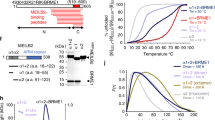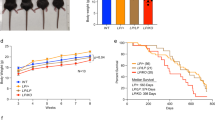Abstract
BLM is a RecQ family helicase that is defective in individuals with the cancer predisposition disorder, Bloom's syndrome (BS). At the cellular level, BS is characterized by hyper-recombination manifested as excessive sister chromatid exchange and loss of heterozygosity. However, the precise function of BLM remains unclear. Multiple roles have been proposed for BLM in the homologous recombination (HR) repair pathway, including ‘early’ functions, such as the stimulation of resection of DNA double-strand break ends or displacement of the invading strand of DNA displacement loops, and ‘late’ roles, such as dissolution of double Holliday junctions. However, most of the evidence for these putative roles comes from in vitro biochemical data. In this study, we report the characterization of mouse embryonic stem cells with disruption of Blm and/or Rad54 genes. We show that Blm has roles both upstream and downstream of the Rad54 protein, a core HR factor. Disruption of Rad54 in the Blm-mutant background reduced the elevated level of gene targeting and of sister chromatid exchanges, implying that Blm primarily functions downstream of Rad54 in the HR pathway. Conversely, however, mutation of Blm in Rad54−/− cells rescued their mitomycin C (MMC) sensitivity, and decreased both the level of DNA damage and cell cycle perturbation induced by MMC, suggesting an early role for Blm. Our data are consistent with Blm having at least two roles in HR repair in mammalian cells.
This is a preview of subscription content, access via your institution
Access options
Subscribe to this journal
Receive 50 print issues and online access
$259.00 per year
only $5.18 per issue
Buy this article
- Purchase on Springer Link
- Instant access to full article PDF
Prices may be subject to local taxes which are calculated during checkout






Similar content being viewed by others
References
Amitani I, Baskin RJ, Kowalczykowski SC . (2006). Visualization of Rad54, a chromatin remodeling protein, translocating on single DNA molecules. Mol Cell 23: 143–148.
Bachrati CZ, Borts RH, Hickson ID . (2006). Mobile D-loops are a preferred substrate for the Bloom's syndrome helicase. Nucleic Acids Res 34: 2269–2279.
Beard C, Hochedlinger K, Plath K, Wutz A, Jaenisch R . (2006). Efficient method to generate single-copy transgenic mice by site-specific integration in embryonic stem cells. Genesis 44: 23–28.
Bugreev DV, Mazina OM, Mazin AV . (2006). Rad54 protein promotes branch migration of Holliday junctions. Nature 442: 590–593.
Bugreev DV, Yu X, Egelman EH, Mazin AV . (2007). Novel pro- and anti-recombination activities of the Bloom's syndrome helicase. Genes Dev 21: 3085–3094.
Chaganti RS, Schonberg S, German J . (1974). A manyfold increase in sister chromatid exchanges in Bloom's syndrome lymphocytes. Proc Natl Acad Sci USA 71: 4508–4512.
Chu WK, Hickson ID . (2009). RecQ helicases: multifunctional genome caretakers. Nat Rev Cancer 9: 644–654.
Dillehay LE, Jacobson-Kram D, Williams JR . (1989). DNA topoisomerases and models of sister-chromatid exchange. Mutat Res 215: 15–23.
Dronkert ML, Beverloo HB, Johnson RD, Hoeijmakers JH, Jasin M, Kanaar R . (2000). Mouse RAD54 affects DNA double-strand break repair and sister chromatid exchange. Mol Cell Biol 20: 3147–3156.
Eisen JA, Sweder KS, Hanawalt PC . (1995). Evolution of the SNF2 family of proteins: subfamilies with distinct sequences and functions. Nucleic Acids Res 23: 2715–2723.
Essers J, Hendriks RW, Swagemakers SM, Troelstra C, de Wit J, Bootsma D et al. (1997). Disruption of mouse RAD54 reduces ionizing radiation resistance and homologous recombination. Cell 89: 195–204.
Essers J, Houtsmuller AB, van Veelen L, Paulusma C, Nigg AL, Pastink A et al. (2002). Nuclear dynamics of RAD52 group homologous recombination proteins in response to DNA damage. Embo J 21: 2030–2037.
Gravel S, Chapman JR, Magill C, Jackson SP . (2008). DNA helicases Sgs1 and BLM promote DNA double-strand break resection. Genes Dev 22: 2767–2772.
Hanada K, Budzowska M, Modesti M, Maas A, Wyman C, Essers J et al. (2006). The structure-specific endonuclease Mus81-Eme1 promotes conversion of interstrand DNA crosslinks into double-strands breaks. Embo J 25: 4921–4932.
Heyer WD, Li X, Rolfsmeier M, Zhang XP . (2006). Rad54: the Swiss Army knife of homologous recombination? Nucleic Acids Res 34: 4115–4125.
Interthal H, Heyer WD . (2000). MUS81 encodes a novel helix-hairpin-helix protein involved in the response to UV- and methylation-induced DNA damage in Saccharomyces cerevisiae. Mol Gen Genet 263: 812–827.
Li X, Stith CM, Burgers PM, Heyer WD . (2009). PCNA is required for initiation of recombination-associated DNA synthesis by DNA polymerase delta. Mol Cell 36: 704–713.
Lim DS, Hasty P . (1996). A mutation in mouse rad51 results in an early embryonic lethal that is suppressed by a mutation in p53. Mol Cell Biol 16: 7133–7143.
Luo G, Santoro IM, McDaniel LD, Nishijima I, Mills M, Youssoufian H et al. (2000). Cancer predisposition caused by elevated mitotic recombination in Bloom mice. Nat Genet 26: 424–429.
Mankouri HW, Ngo HP, Hickson ID . (2007). Shu proteins promote the formation of homologous recombination intermediates that are processed by Sgs1-Rmi1-Top3. Mol Biol Cell 18: 4062–4073.
Marple T, Kim TM, Hasty P . (2006). Embryonic stem cells deficient for Brca2 or Blm exhibit divergent genotoxic profiles that support opposing activities during homologous recombination. Mutat Res 602: 110–120.
Mazina OM, Mazin AV . (2008). Human Rad54 protein stimulates human Mus81-Eme1 endonuclease. Proc Natl Acad Sci USA 105: 18249–18254.
Mimitou EP, Symington LS . (2008). Sae2, Exo1 and Sgs1 collaborate in DNA double-strand break processing. Nature 455: 770–774.
Nimonkar AV, Ozsoy AZ, Genschel J, Modrich P, Kowalczykowski SC . (2008). Human exonuclease 1 and BLM helicase interact to resect DNA and initiate DNA repair. Proc Natl Acad Sci USA 105: 16906–16911.
Otsuki M, Seki M, Inoue E, Yoshimura A, Kato G, Yamanouchi S et al. (2007). Functional interactions between BLM and XRCC3 in the cell. J Cell Biol 179: 53–63.
Ralf C, Hickson ID, Wu L . (2006). The Bloom's syndrome helicase can promote the regression of a model replication fork. J Biol Chem 281: 22839–22846.
Raynard S, Bussen W, Sung P . (2006). A double Holliday junction dissolvasome comprising BLM, topoisomerase IIIalpha, and BLAP75. J Biol Chem 281: 13861–13864.
Rijkers T, Van Den Ouweland J, Morolli B, Rolink AG, Baarends WM, Van Sloun PP et al. (1998). Targeted inactivation of mouse RAD52 reduces homologous recombination but not resistance to ionizing radiation. Mol Cell Biol 18: 6423–6429.
Ristic D, Wyman C, Paulusma C, Kanaar R . (2001). The architecture of the human Rad54-DNA complex provides evidence for protein translocation along DNA. Proc Natl Acad Sci USA 98: 8454–8460.
Singh TR, Ali AM, Busygina V, Raynard S, Fan Q, Du CH et al. (2008). BLAP18/RMI2, a novel OB-fold-containing protein, is an essential component of the bloom helicase-double Holliday junction dissolvasome. Genes Dev 22: 2856–2868.
Solinger JA, Kiianitsa K, Heyer WD . (2002). Rad54, a Swi2/Snf2-like recombinational repair protein, disassembles Rad51:dsDNA filaments. Mol Cell 10: 1175–1188.
Sonoda E, Sasaki MS, Morrison C, Yamaguchi-Iwai Y, Takata M, Takeda S . (1999). Sister chromatid exchanges are mediated by homologous recombination in vertebrate cells. Mol Cell Biol 19: 5166–5169.
Swagemakers SM, Essers J, de Wit J, Hoeijmakers JH, Kanaar R . (1998). The human RAD54 recombinational DNA repair protein is a double-stranded DNA-dependent ATPase. J Biol Chem 273: 28292–28297.
Tan TL, Kanaar R, Wyman C . (2003). Rad54, a Jack of all trades in homologous recombination. DNA Repair (Amst) 2: 787–794.
te Riele H, Maandag ER, Berns A . (1992). Highly efficient gene targeting in embryonic stem cells through homologous recombination with isogenic DNA constructs. Proc Natl Acad Sci USA 89: 5128–5132.
Tsuzuki T, Fujii Y, Sakumi K, Tominaga Y, Nakao K, Sekiguchi M et al. (1996). Targeted disruption of the Rad51 gene leads to lethality in embryonic mice. Proc Natl Acad Sci USA 93: 6236–6240.
van Brabant AJ, Ye T, Sanz M, German IJ, Ellis NA, Holloman WK . (2000). Binding and melting of D-loops by the Bloom syndrome helicase. Biochemistry 39: 14617–14625.
Van Komen S, Petukhova G, Sigurdsson S, Stratton S, Sung P . (2000). Superhelicity-driven homologous DNA pairing by yeast recombination factors Rad51 and Rad54. Mol Cell 6: 563–572.
Wang W, Seki M, Narita Y, Sonoda E, Takeda S, Yamada K et al. (2000). Possible association of BLM in decreasing DNA double strand breaks during DNA replication. Embo J 19: 3428–3435.
Wesoly J, Agarwal S, Sigurdsson S, Bussen W, Van Komen S, Qin J et al. (2006). Differential contributions of mammalian Rad54 paralogs to recombination, DNA damage repair, and meiosis. Mol Cell Biol 26: 976–989.
Wu L, Bachrati CZ, Ou J, Xu C, Yin J, Chang M et al. (2006). BLAP75/RMI1 promotes the BLM-dependent dissolution of homologous recombination intermediates. Proc Natl Acad Sci USA 103: 4068–4073.
Wu L, Davies SL, Levitt NC, Hickson ID . (2001). Potential role for the BLM helicase in recombinational repair via a conserved interaction with RAD51. J Biol Chem 276: 19375–19381.
Wu L, Hickson ID . (2003). The Bloom's syndrome helicase suppresses crossing over during homologous recombination. Nature 426: 870–874.
Xu D, Guo R, Sobeck A, Bachrati CZ, Yang J, Enomoto T et al. (2008). RMI, a new OB-fold complex essential for Bloom syndrome protein to maintain genome stability. Genes Dev 22: 2843–2855.
Zhang R, Sengupta S, Yang Q, Linke SP, Yanaihara N, Bradsher J et al. (2005). BLM helicase facilitates Mus81 endonuclease activity in human cells. Cancer Res 65: 2526–2531.
Zhu Z, Chung WH, Shim EY, Lee SE, Ira G . (2008). Sgs1 helicase and two nucleases Dna2 and Exo1 resect DNA double-strand break ends. Cell 134: 981–994.
Acknowledgements
We thank Dr A Bradley for Blmm3/m4 cells, and Drs H te Riele and D Adams for the targeting vectors. We also thank Drs L Wu, P McHugh and CZ Bachrati for helpful comments on the paper, Mr PS North for advice on SCE assays and Miss P White for preparing the paper. This work was supported by Cancer Research UK and by The Bloom's Syndrome Foundation (IDH), and by The Netherlands Genomic Initiative/The Netherlands Organization for Scientific Research (RK). WK Chu was supported by the Anita Mui ‘True Heart’ Charity Foundation, the K P Tin Foundation Limited and the China Oxford Scholarship Fund.
Author information
Authors and Affiliations
Corresponding author
Ethics declarations
Competing interests
The authors declare no conflict of interest.
Additional information
Supplementary Information accompanies the paper on the Oncogene website
Rights and permissions
About this article
Cite this article
Chu, W., Hanada, K., Kanaar, R. et al. BLM has early and late functions in homologous recombination repair in mouse embryonic stem cells. Oncogene 29, 4705–4714 (2010). https://doi.org/10.1038/onc.2010.214
Received:
Revised:
Accepted:
Published:
Issue Date:
DOI: https://doi.org/10.1038/onc.2010.214
Keywords
This article is cited by
-
Investigating the pathogenic SNPs in BLM helicase and their biological consequences by computational approach
Scientific Reports (2020)
-
Cooperation of Blm and Mus81 in development, fertility, genomic integrity and cancer suppression
Oncogene (2015)
-
Time to Bloom
Genome Integrity (2010)



